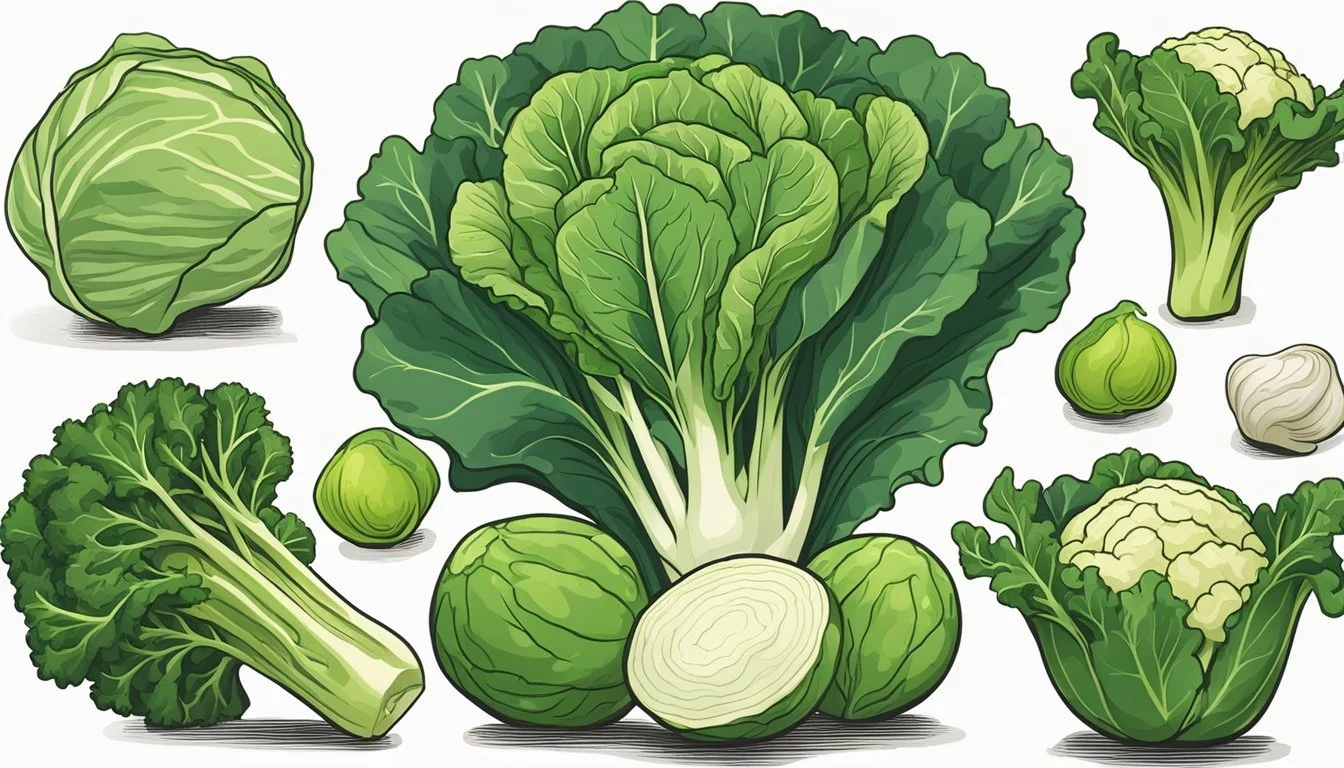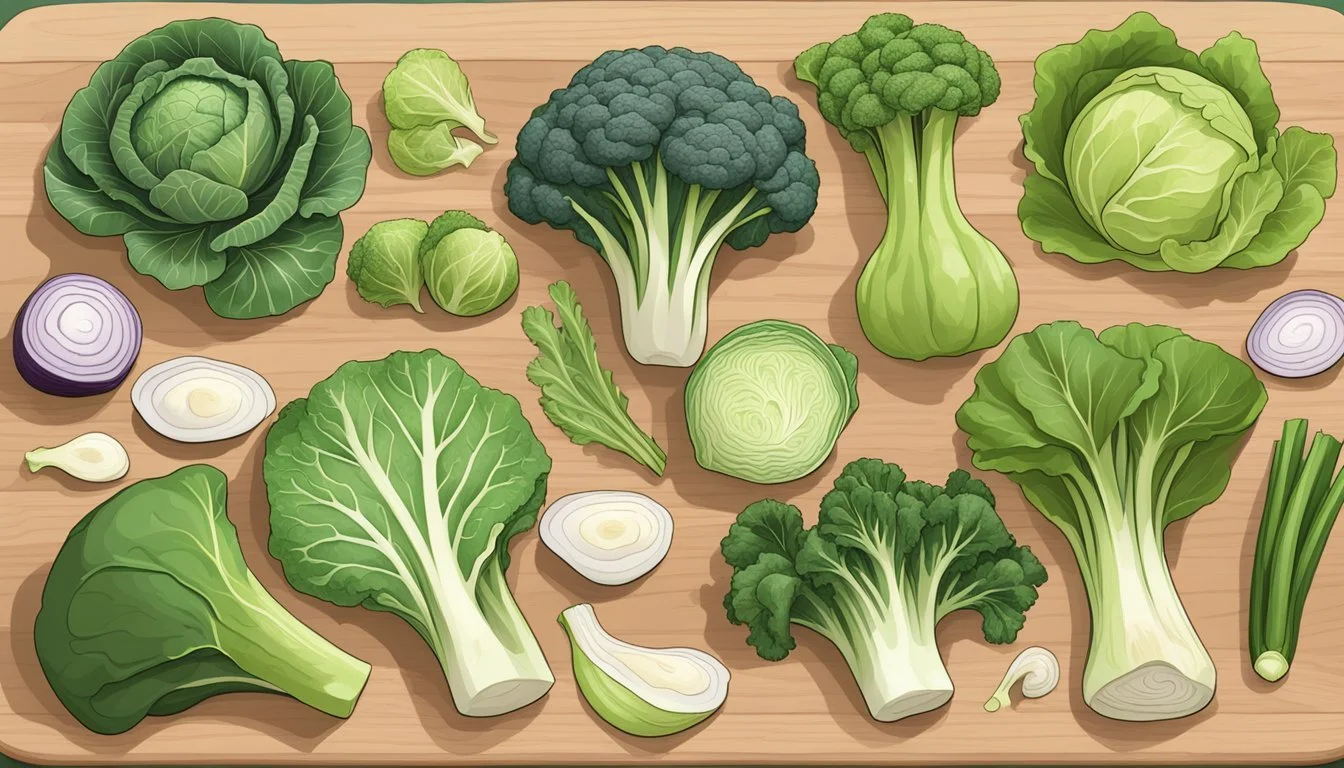Cabbage Substitutes
Top Alternatives for Your Recipes
Cabbage is a staple in many recipes around the world, lauded for its versatility and nutritional value. From coleslaw to stir-fries, cabbage offers a crunchy texture and a slightly sweet yet peppery flavor profile that can complement a variety of dishes. However, there are instances when cabbage might not be readily available, or some might prefer an alternative due to dietary restrictions, flavor preference, or simply for a twist in the usual recipe.
In such cases, there exists a range of suitable cabbage substitutes that can fill in for the cruciferous vegetable without compromising the overall integrity of a dish. Leafy greens such as kale and bok choy provide similar nutritional benefits and can be used in similar culinary applications, from raw salads (What wine goes well with salads?) to cooked meals. For those looking to mirror the texture and bulk of cabbage in cooked dishes, options like brussels sprouts and savoy cabbage are excellent choices, offering a comparable mouthfeel and flavor profile.
Selecting an appropriate substitute depends on the desired outcome in both texture and flavor. Some alternatives may offer a more robust flavor, while others might be milder, adding subtle nuances to a dish. Understanding the characteristics of these substitutes can lead to successful culinary experiments and satisfying meals, even in the absence of traditional cabbage.
Understanding Cabbage Substitutes
When considering a substitute for cabbage in a recipe, it is important to assess the alternative's texture and flavor profile, nutritional value, and how it compares in common uses within various dishes.
Texture and Flavor Profiles
The texture of a cabbage substitute should ideally mimic that of cabbage, which is generally crisp and can provide a satisfying bite. Kale and bok choy are excellent alternatives for their similar textures; kale is particularly hearty, while bok choy offers a tender crispness that suits many recipes.
Kale: A robust leafy green with a chewier texture and a slightly bitter taste.
Bok Choy: Offers a lighter, tender yet crisp texture, with a mild flavor.
Brussels Sprouts: Small and dense, providing more bite, and a bold, nutty flavor.
Nutritional Value
Cabbage is celebrated for its rich nutrient content, which includes vitamins A, C, and K, alongside a variety of minerals such as manganese. Many cabbage alternatives also offer valuable nutrients:
Kale: Rich in fiber, vitamins A, C, and K.
Brussels Sprouts: Good source of antioxidants and fiber, with high vitamin C content.
Napa Cabbage: Offers a similar nutrient profile to regular cabbage with antioxidants and lower calories.
Common Uses in Recipes
The chosen substitute should function well within the recipe's context, maintaining the integrity of the dish's intended flavor and presentation. Cabbage is versatile and can be used in salads, stir-fries, and as wraps:
Salads: Iceberg lettuce and kale are popular in salads for their crisp texture.
Stir-fries: Bok choy and napa cabbage work well in stir-fries due to their ability to retain a slight crunch.
Wraps: Collard greens make sturdy wraps and are an ideal replacement for cabbage leaves.
Each of these substitutes can be used effectively in a variety of recipes calling for cabbage, making them good alternatives based on the specific requirements of the dish.
Popular Cabbage Substitutes
When seeking alternatives to cabbage, individuals often turn to other vegetables that can provide similar textures and nutritional benefits. Here are some common replacements divided into three categories.
Leafy Greens as Substitutes
Among leafy greens, kale is a standout due to its rich vitamin content, especially vitamins A, C, and K, and essential minerals like calcium and iron. Varieties such as baby kale, curly kale, and spinach serve well in raw applications like salads. Collard greens, while heartier, can be cooked to mimic the texture of cooked cabbage and are full of micronutrients.
Kale: Good for both raw and cooked dishes; offers a slight bitter taste.
Spinach: Suitable for salads and lightly cooked dishes; rich in iron.
Collard Greens: Best for longer cooking methods; robust flavor and texture.
Cruciferous Vegetables
Other members of the cruciferous family, such as Brussels sprouts and kohlrabi, can be used as cabbage substitutes due to their similar taste profiles and nutrient contents. These vegetables are high in vitamin C and potassium.
Brussels Sprouts: Roast or steam to bring out a sweet, nutty flavor.
Kohlrabi: Can be eaten raw or cooked, and its texture is comparable to that of cabbage stems.
Other Vegetable Alternatives
Vegetables like bok choy, also known as Chinese cabbage, and Napa cabbage are excellent in cooked dishes as they maintain structure while offering a tender bite. Endives and lettuces like iceberg and romaine are crisp options suited for salads and slaws.
Bok Choy: Delivers a mild, peppery flavor, perfect for stir-fries and steamed dishes.
Napa Cabbage: Milder and sweeter than regular cabbage; works well in salads and cooked meals.
Iceberg Lettuce: Crisp and refreshing; a common salad base.
Romaine Lettuce: Slightly more nutritious than iceberg with a sturdier leaf, excellent for salads and wraps.
Ideal Cabbage Alternates for Specific Dishes
Selecting the right substitute for cabbage in various dishes is crucial as it impacts the texture, flavor, and nutritional value. The following subsections aim to provide specific alternatives for different types of dishes, ensuring culinary success.
Salads and Slaws
For salads and slaws, one seeks ingredients that can provide a satisfying crunch and hold up well when dressed.
Kale: This is a robust leafy green that works excellently in salads due to its texture and nutritional profile.
Iceberg lettuce: Offers a crispness and light flavor, making it suitable for slaws.
Endives: Their slightly bitter taste adds a unique flavor contrast in salads.
Soups and Stir-Fries
In soups and stir-fries, a cabbage alternative should maintain structural integrity and absorb flavors effectively.
Bok Choy: Recognized for its crispness and ability to soak up broth and sauces, it's well-suited for Asian cuisine dishes.
Napa cabbage: Another great option for stir-fries due to its softer texture and milder taste.
Roasted and Sautéed Preparations
When roasted or sautéed, substitutes should mirror cabbage's density and ability to caramelize.
Brussels sprouts: These can be roasted to bring out a sweet, nutty flavor akin to cabbage.
Kohlrabi: It has a similar texture and can be sautéed for a substitute that mimics cabbage's hearty feel.
Stuffed and Baked Recipes
Stuffed and baked recipes, such as cabbage rolls and stuffing recipes, require substitutes that can hold fillings without falling apart.
Savoy cabbage: An alternative with similar hearty leaves that are ideal for wrapping and baking.
Choy sum: Its leaves are sturdy enough to handle stuffing preparations, commonly used in stuffed dumplings in Asian cuisine.
Selecting Cabbage Substitutes
When choosing a substitute for cabbage, the individual should consider texture, flavor, and nutritional content to best match the original ingredient's characteristics and intended use in a recipe.
Considerations for Texture
Cabbage is celebrated for its crunchy texture when raw and firm texture upon cooking. Appropriate substitutes vary based on the desired texture in the final dish. For a crunchy texture, options like Iceberg lettuce and celery may be considered. They hold up well in salads and slaws. For recipes requiring a firm texture that can withstand prolonged cooking, one might explore vegetables like Brussels sprouts or kohlrabi, both showing resilience similar to cabbage.
Assessing Flavor Complement
The sweet flavor of cabbage is a subtle yet pervasive feature in dishes. Alternatives like bok choy and Napa cabbage offer a sweet taste with a hint of earthiness, closely aligning with the taste profile of traditional cabbage, making them excellent for a variety of dishes. If a recipe can accommodate a bitter taste, options such as kale or collard greens provide a robust flavor, while also introducing a unique profile to the dish.
Nutritional Content Comparisons
Cabbage is renowned for its nutrition, packed with vitamins A, C, and K. When evaluating substitutes, one should compare their nutritional profiles to ensure they provide similar benefits. Kale, for instance, is also nutrient-rich, offering high levels of the same vitamins as well as fiber and antioxidants.
Vitamins A, C, and K: Kale and Brussels sprouts
Fiber: Collard greens and kale
Antioxidants: Kale and bok choy
To preserve the healthful qualities of cabbage in a dish, these substitutes are not just chosen for taste and texture but for their nutritional content as well. They must maintain a balance to support a varied and health-conscious diet.
Miscellaneous Cabbage Substitute Information
When selecting substitutes for cabbage in various recipes, it's essential to consider factors such as water content, unique attributes of each vegetable, and other practical considerations that affect texture, flavor, and cooking time.
Varied Water Content
Different vegetables have varying levels of water content which can affect the texture and cooking method required for your dish. For example:
Kale and Bok Choy: Lower water content than cabbage, offering a firmer texture.
Iceberg Lettuce and Celery: High water content, leading to a more tender texture when cooked.
Water Content Comparison
Vegetable Water Content Suggested Use Green Cabbage High Slaws, Stews Iceberg Lettuce Very High Salads Kale Medium Sautéed Dishes Bok Choy Medium-High Stir-fries, Steaming
Unique Attributes
Each substitute within the Brassica family brings its own unique attributes to a recipe:
Flavor: Kale has a slightly bitter taste while Bok Choy is milder and celery offers a crisp, clean flavor.
Color: Red and purple cabbage varieties can add vibrant color to dishes.
Nutritional Value: Many substitutes are considered superfoods; kale and Bok Choy are rich in vitamins A, C, and K.
Attribute Highlights
Vegetable Flavor Color Nutritional Benefit Red Cabbage Mildly peppery Purple hue Vitamin C and K Kale Bitter Dark green Vitamins A, C, and K Savoy Cabbage Sweet and tender Crinkled leaves Folate and Fiber
Other Considerations
Versatility: Some substitutes are more versatile than others. For instance, while savoy cabbage can be used in a similar manner to green cabbage, it may not hold up as well when pickled or fermented.
Cooking Time: Heavier leaves like those of kale or collard greens may require longer cooking times compared to the softer leaves of Napa cabbage.
Usage: Substitutes should be chosen based on the intended use. Tender greens are better for raw applications whereas sturdy ones are suitable for cooking.
Usage and Cooking Time Guide
Vegetable Best Used In Cooking Time Collard Greens Soups, Stir-fries Longer Napa Cabbage Salads, Wraps Short to None Brussels Sprouts Roasted Dishes Longer
Bear in mind that while there are many substitutes for cabbage, each can impart a slightly different result in your final dish. Therefore, consider the desired outcome in terms of texture, flavor, and appearance when choosing your alternative.





